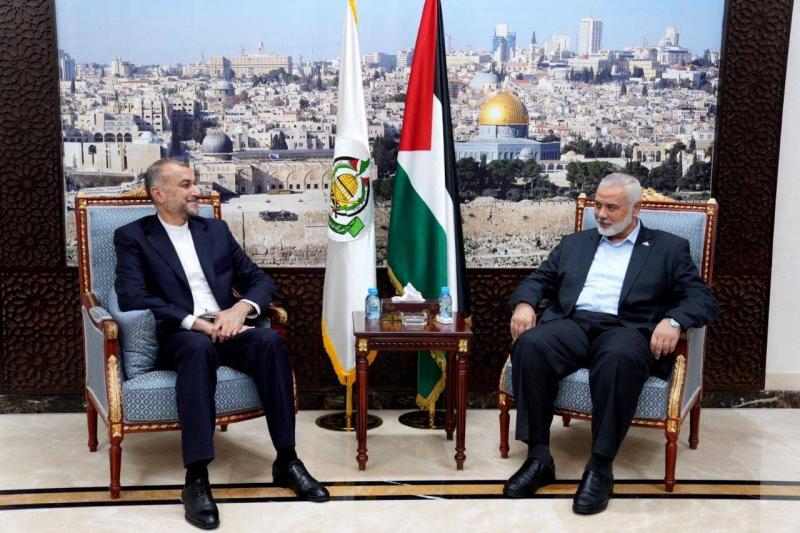Recent statements from Iranian officials and Hamas have highlighted the assessment of relations between Tehran and the movement, particularly following the "Al-Aqsa Flood" operation, questioning whether it is characterized by cooperation or dependency. Political analysts are examining the support Iran provides to Hamas, their points of disagreement and agreement, and the Iranian Supreme Leader Ali Khamenei’s plan regarding Israel by 2040, and how all of this affects the evaluation of their relationship.
On Wednesday, the spokesperson for the Iranian Revolutionary Guard, Ramadan Sharif, stated in a televised interview that the "Al-Aqsa Flood," carried out by Hamas on October 7 against Israel, was a retaliation for the assassination of Quds Force leader Qassem Soleimani. However, Hamas denied this, asserting that the operation was aimed at the threats facing the Al-Aqsa Mosque.
Palestinian writer Ziad Abu Amr noted that Iran provided "logistical support and military training to Hamas members in 1994," alongside financial assistance estimated in millions of dollars, which has significantly increased over time. In February 1999, Palestinian police reportedly discovered documents indicating that Iranian intelligence transferred $35 million to Hamas to fund activities against Israel.
In addition to financial aid, Iran trained Hamas members to carry out attacks. Hassan Salameh, a Hamas leader behind the 1996 bombings, recounted that he received ideological training in Sudan and was then sent to Syria and subsequently to Iran, where he underwent military training for three months.
Following the assassination of Hamas leader Abdul Aziz al-Rantisi in 2004, and before him Ahmed Yassin, which weakened the movement, Iran increased its funding. Reports indicated efforts by Hamas leader Khaled Meshaal to secure additional funding and establish direct communication with the Revolutionary Guard.
Support increased after Hamas seized control of Gaza by force and overthrew the Palestinian Authority in 2007. According to a 2010 U.S. Department of Defense report on Iran's military capability, Tehran provided funding, weapons, and training to Palestinian factions, including Hamas, to obstruct the peace process.
In 2012, the U.S. State Department confirmed that Hamas used smuggling tunnels from Egypt and maritime routes to deliver weapons from Iran to Gaza. However, relations soured in 2012 when Hamas sided with the armed opposition in Syria while Tehran supported the government, leading to Khaled Meshaal's departure from Damascus, and Hamas deputy leader Musa Abu Marzook indicated that the Iranians were dissatisfied with Hamas's position.
Despite this, Iran continued to offer partial support, particularly on the military front, and starting in 2014, relations began to improve. Palestinian political analyst Zaid al-Ayubi argued that the relationship had turned into complete dependency following significant financial and military support, and that this "manifested in the bloody coup the movement conducted against the Palestinian Authority in 2007, resulting in the deaths of around a thousand Palestinians."
Al-Ayubi cited a statement from Hamas leader Ismail Haniyeh in a television interview, declaring that the purpose of Hamas's operations is to distract Israel and the U.S. from the war on Iran. Regarding the current conflict, he stated that Iran "uses Hamas to achieve its interests in a proxy war, leading to Palestinian involvement in a tragedy." He asserted that Tehran "cannot accept Hamas as a partner but rather turns it into a proxy and Iranian arm, undermining Palestinian national unity contrary to Iran's interests."
American researcher specializing in international affairs, Irina Tsukerman, agrees with al-Ayubi's view of "dependency," stating that while Hamas began as a Muslim Brotherhood entity and an ally of Tehran, it has become a "complete proxy" for it. She noted that both parties "share the goal of destroying Israel" and maintain coordination, referencing regular meetings between Hamas leaders and Iranian officials in Tehran, Doha, and Beirut, similar to what is customary with Iran's proxies.
According to the researcher, Iran "coordinated the October 7 attack." However, it remains unclear whether the attack was a retaliation for Soleimani's assassination, carried out by Americans in 2020, or merely part of Khamenei's plan to destroy Israel, announced in 2015, intended for completion by 2040. Khamenei had stated during a public reception in 2015 that within 25 years, "nothing named Israel will exist," a sentiment he has reiterated on several occasions since.
Conversely, Iranian affairs expert Mahmoud Jaber denies that Hamas forms part of Iran's proxies, even with some degree of alignment. However, he anticipates changes following October 7, suggesting that "Iranian relations after this date differ from those before it; the current phase temporarily compels Hamas to accept any state or party that stands with it in the ongoing war."
Jaber describes the Revolutionary Guard spokesperson’s statement regarding the "Al-Aqsa Flood" as "political opportunism," sending a message that Hamas is a proxy of Tehran. He concludes that "it is difficult to assess the relationship between both sides during this stage due to the historical situation the movement and the Palestinian issue are undergoing, and the authority of the movement in Gaza, which has become threatened."




